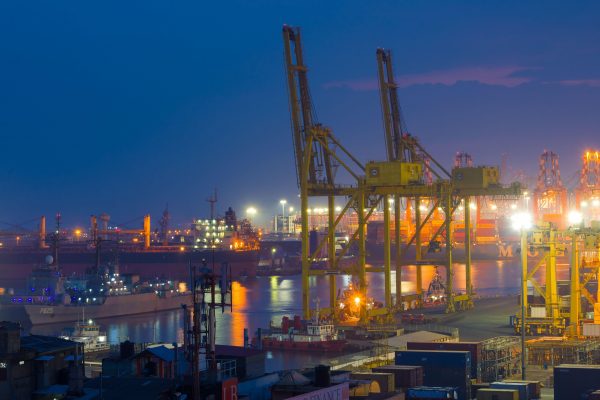Rising inflation has outpaced the recovery in the real economy. Advanced economies have started to withdraw the monetary stimulus provided during the pandemic, taper off quantitative easing and raise central bank interest rates, which signals monetary policy tightening.
Disruptions in supply chains and rising petroleum prices before Russia’s invasion of Ukraine caused challenges in managing global inflation and growth. Russia and Ukraine combined have a significant share of global supplies of oil, gas and other commodities, so the invasion has increased commodity prices. Volatility in global financial markets has increased due to concerns on the timing and extent of major central banks tightening monetary policy tightening.
The direct impact on South Asia will mainly occur through trade linkages, particularly through rising commodity prices as the region is a net importer of commodities. Even before the invasion, inflation in South Asian economies was rising relative to competitors in global markets. The additional shock in commodity prices will further widen the gap — increasing the relative cost of production in the region — and erode the competitiveness of cheap labour and energy-intensive industries. Dependence on fossil fuels for energy generation is higher in South Asia than elsewhere in Asia.
Lower global demand for goods and services from the region and increased volatility and uncertainty in financial markets leading to capital flight to safety will indirectly impact the region.
The direct impact will immediately translate to higher relative inflation while the indirect impact will result in lower economic growth leading to stagflation in the second round. The extent of the economic hit on South Asia will depend on the duration of the conflict, the severity of Western sanctions on Russia and Russia’s policy response. The blow to individual South Asian countries will vary depending on their economic linkages with Russia and Ukraine, and the growth and financial market linkages to the rest of the world.
Stronger Western sanctions against Russia for a longer period will cause a persistent rise in commodity prices and global inflation. This would have adverse implications on global growth leading to lower external demand for South Asian exports. Inflation in South Asia rose in the aftermath of the pandemic, increasing income inequalities and pushing more people into poverty. A full invasion scenario is likely to further increase the region’s inflation which will hamper growth and widen income inequalities.
A sustained conflict could have a more lasting and more drastic effect on South Asia. The worst-case scenario is a full-scale war in Europe. The situation may deteriorate further with the use of nuclear weapons as Russia is playing a ‘chess game’ with the West including putting its nuclear forces on high alert. The economic fallout for South Asia from the worst-case scenario would be more adverse than the total economic impact of the COVID-19 pandemic. It could tip the global economy into its second recession in three years with possible differential effects across South Asia.
Due to its bigger domestic market, India may be able to sustain positive (but lower) growth for some period. Bangladesh is heavily dependent on exports and remittances, so it will also be affected by lower external demand through the growth channel.
Smaller economies, which are more vulnerable to external shocks — Bhutan, Nepal, Maldives and Sri Lanka — could see larger shorter-term growth contractions than India and Bangladesh. Pakistan’s economy, suffering from multiple vulnerabilities, is also likely to contract. Tourism and trade linkages will take a hit in smaller countries like Sri Lanka and the Maldives. Russia and Ukraine are important tourism markets for these countries — for example, Russia imports about 20 per cent of Sri Lankan tea.
As financial flows are low with Russia and Ukraine, South Asia’s financial markets are likely to be insulated from the conflict in the short term. But global financial flows to South Asia could be indirectly affected due to volatility in global financial markets.
Sanctions on Russia can create opportunities for countries in Asia to benefit as Russia is likely to look for more trade with friendly or neutral countries like China and India to circumvent sanctions by the West. Similar trade diversion was observed when the United States imposed sanctions against Iran. Iran shifted to trading with some European and Middle Eastern countries, while India and China conducted barter trade with Iran, exchanging crude oil for food. But such benefits may not be sufficient to offset the cost of higher commodity prices and lower external demand for South Asian countries.
Economic management in South Asia during heightened global uncertainties from the Russia–Ukraine conflict will be challenging. India can minimise the growth impact through domestic demand management policies using available monetary and fiscal policy. Other South Asian countries will be forced to absorb the impacts of lower external demand and volatile financial market conditions through economic contraction, leading more people to fall below the poverty line.
Nandalal Weerasinghe is an independent consultant and a former Senior Deputy Governor of the Central Bank of Sri Lanka.
Ganeshan Wignaraja is a Non-Resident Senior Fellow at the Institute of South Asian Studies of the National University of Singapore.


If I were India, I would be very nervous that Russia’s isolation would push it into becoming a client state of China. Aside from all of the negative economic fallout, their main arms supplier could start selling less than cutting edge kit to them. China is the main strategic threat to India, with Pakistan being a proxy. Russia has been a partner for India, but its status is now problematic. This leaves India’s preference for non-alignment (which is reasonable) at a crossroads.